#2024 Toyota Camry For Sale
Text
Competitive Analysis & Strategy in Hybrid Vehicle Industry
The global automotive landscape is undergoing a transformative shift, with the hybrid vehicle market emerging as a pivotal segment. Hybrid vehicles, which combine internal combustion engines with electric propulsion systems, have gained traction as a bridge technology towards full electrification. This blog delves into the hybrid vehicle market, offering a detailed examination of its current size, share, and growth trajectory, identifying key market trends, assessing major players, and discussing the challenges that could impact future growth.
Market Size, Share, and Growth
As of 2024, the global hybrid vehicle market is valued at approximately USD 340 billion, with expectations to reach USD 470 billion by 2028, growing at a compound annual growth rate (CAGR) of 8.5% from 2023 to 2028. The market’s growth is propelled by a confluence of factors, including increasing environmental concerns, stringent emission regulations, and advancements in hybrid technology.
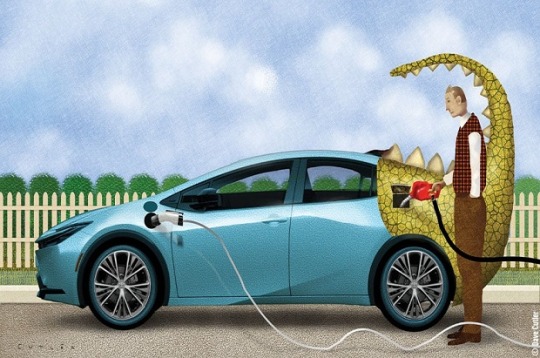
The Asia-Pacific region dominates the market, accounting for over 45% of the global share, driven by high adoption rates in countries like Japan, China, and South Korea. North America follows, holding around 30% of the market share, with the U.S. being a key contributor due to favorable government policies and consumer awareness. Europe also plays a significant role, representing approximately 20% of the market, largely due to stringent EU emission standards and the region’s push towards sustainable mobility solutions.
Market Trends
Technological Advancements and Innovations: The hybrid vehicle market is witnessing significant technological innovations, including the development of plug-in hybrid vehicles (PHEVs), which offer extended electric-only ranges. Battery technology advancements, such as solid-state batteries, are also contributing to improved vehicle efficiency, driving consumer interest.
Government Policies and Incentives: Governments worldwide are implementing policies to promote hybrid vehicles as part of their broader environmental and energy efficiency goals. Tax incentives, subsidies, and stricter emission regulations are some of the tools being used to encourage both manufacturers and consumers to shift towards hybrid technology.
Increasing Consumer Awareness: Consumers are becoming more aware of the environmental impact of their vehicle choices. The hybrid vehicle market benefits from this shift in consumer preference, particularly among environmentally conscious buyers looking for alternatives to traditional internal combustion engine vehicles without fully committing to electric vehicles (EVs).
Expansion of Charging Infrastructure: The expansion of charging infrastructure, particularly for PHEVs, is a crucial trend. Governments and private companies are investing heavily in developing extensive charging networks, making hybrid vehicles a more convenient and practical option for a broader audience.
Rise of Sustainable Mobility Solutions: Hybrid vehicles are increasingly seen as part of a broader trend towards sustainable mobility solutions. This trend encompasses the integration of hybrids into car-sharing platforms, fleet services, and urban mobility initiatives, further driving market growth.
Key Market Players
Toyota Motor Corporation: As a pioneer in the hybrid vehicle market with its iconic Prius model, Toyota continues to lead the industry. The company holds a significant market share of approximately 20% globally, driven by a diverse portfolio that includes hybrid versions of popular models like the Camry, RAV4, and Corolla. Toyota's hybrid sales reached nearly 2.5 million units in 2023.
Honda Motor Co., Ltd.: Honda has established itself as a key player with models like the Accord Hybrid and CR-V Hybrid. The company holds around 10% of the market share, with sales figures exceeding 1.2 million units in 2023. Honda's focus on fuel efficiency and reliability has made its hybrids popular across various markets.
Ford Motor Company: Ford’s hybrid lineup, including models like the Ford Escape Hybrid and Ford Explorer Hybrid, contributes to its 8% global market share. The company is focusing on expanding its hybrid offerings as part of its broader electrification strategy, with sales approaching 1 million units in 2023.
Hyundai Motor Company: Hyundai, along with its subsidiary Kia, holds a combined market share of approximately 12%. The Hyundai Ioniq Hybrid and Kia Niro Hybrid are among the best-selling models. The company is also exploring advanced hybrid technologies to maintain its competitive edge, with combined sales surpassing 1.5 million units in 2023.
BMW Group: BMW’s commitment to sustainability is evident in its hybrid offerings, including the BMW 3 Series Hybrid and BMW X5 Hybrid. The company holds about 5% of the market share, with a focus on luxury hybrids that combine performance with environmental responsibility. BMW's hybrid sales exceeded 600,000 units in 2023.
Market Challenges
High Production Costs: The production costs associated with hybrid vehicles remain higher than those of traditional vehicles, primarily due to the complexity of hybrid powertrains and the use of expensive materials in battery production. These costs are often passed on to consumers, making hybrids less affordable for price-sensitive buyers.
Battery-Related Issues: Although battery technology is improving, challenges related to battery life, degradation, and recycling persist. The environmental impact of battery disposal and the limited availability of raw materials for battery production are significant concerns that could affect market growth.
Competition from Electric Vehicles (EVs): The rapid growth of the EV market presents a challenge for hybrid vehicles. As battery prices continue to fall and charging infrastructure expands, consumers may increasingly opt for fully electric vehicles, which could reduce the demand for hybrids.
Consumer Perception and Awareness: Despite growing awareness, some consumers remain skeptical about the benefits of hybrid vehicles, particularly in terms of long-term savings and environmental impact. Misconceptions about hybrid technology can hinder market growth, particularly in regions where consumer education is lacking.
Regulatory and Policy Uncertainty: The hybrid vehicle market is heavily influenced by government policies and regulations. Any changes in tax incentives, subsidies, or emission standards can have a significant impact on market dynamics. The uncertainty surrounding future regulatory frameworks poses a challenge for both manufacturers and consumers.
Conclusion
The hybrid vehicle market is poised for significant growth in the coming years, driven by technological advancements, supportive government policies, and changing consumer preferences. However, the market is not without its challenges. High production costs, battery-related issues, competition from EVs, and regulatory uncertainties could hinder the market’s potential. Despite these challenges, the hybrid vehicle market remains a crucial component of the global automotive industry’s transition towards more sustainable mobility solutions. As major players continue to innovate and expand their hybrid offerings, the market is likely to see sustained growth, particularly in regions where infrastructure and consumer awareness are aligned with environmental goals. In conclusion, while the hybrid vehicle market faces a complex landscape, it also offers substantial opportunities for growth and development in the quest for a greener future.
#Hybrid Vehicle Market#hybrid vehicles in india#mild hybrid vehicle#used hybrid cars Market#Hybrid Vehicle Industry
0 notes
Text
Why Americans Stopped Buying Convertibles
We’ve Traded the Open-air Dream For Climate-Controlled Isolation.
— Mark Dent | May 3, 2023

A year after I graduated college, I decided to buy a car. I’d been driving a hand-me-down Hyundai sedan, but I wanted something more reliable for the miles I racked up driving around sprawling Dallas for my job as a reporter.
At first, I narrowed my search to the Mazda 6 — at least it was more fun than a Corolla. But as I saved a few options online, hoping for something in dark green, I said to hell with all that. I could buy a convertible for roughly the same price.
A couple weeks later, a dealer showed me a 2004 Ford Mustang, white with a cream-colored canvas top. He pressed a switch on the center console, and down went the top for my test drive. I’d never ridden in a convertible before. On back roads twisting through farmland, it felt like the sky had been lowered from the atmosphere, settling just a few feet above me, close enough to touch the clouds.
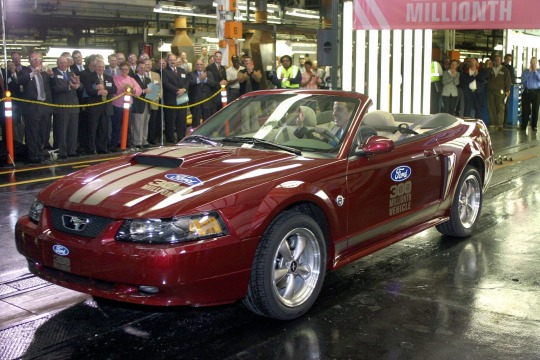
An early 2000s Mustang. Bill Pugliano/Getty Images
I bought the Mustang and drove it back into the city with the top down. Over the next couple years, I drove it like that as often as I could: on cool nights with the heat turned on and windows rolled up, on a summer road trip nearly all the way through Kansas until the sunburn became unbearable.
I never got sick of the convertible. It turned everyday monotony into an adventure, replaced the rigid confinement of sedans and SUVs with freedom and openness. Who wouldn’t want one?
But the year I bought my Mustang, in 2010, US convertible sales were down to ~140K, less than half of what they’d been just a few years earlier. That was during the Great Recession, near the auto industry’s nadir. Still, the decline has continued.
According to S&P Global Mobility, new retail registrations of convertibles totaled ~70K in the 12 months between March 2023 and February 2024, comprising ~0.6% of all vehicle sales. That’s down from ~2% in the mid-2000s.
2023 sales of the Mustang convertible, which celebrates its 60th anniversary this year, were down ~87% compared to 2001. Its rival, the Chevrolet Camaro, has been discontinued.
Convertibles are an endangered species, along with the American ethos they exemplified. When Carvana polled Americans on their dream cars last year, the most coveted was an SUV. The characteristic they sought most in their dream car wasn’t emotional attachment — it was technology.
We’re losing the messy, hair-flowing-in-the-wind version of the American Dream to something climate-controlled and closed off to the world. And we might never get it back.
The Car That ‘Satisfies A Youthful Ambition’
Growing up in the ’90s, I rode countless, boring miles in the passenger seats of my dad’s Toyota Camry sedan and mom’s Plymouth Voyager minivan.
I pined for a more exotic ride just out of my reach. My next-door neighbor had an old European convertible — a midlife crisis purchase if there ever were one — and I remember the college-aged woman across the street pulling into her family’s driveway (and looking far cooler) in a Mazda Miata.
This yearning went back generations, to the time automakers, after painstakingly working to enclose early model cars with roofs, realized they could spark people’s imaginations (and extract more from their wallets) by offering a topless experience.
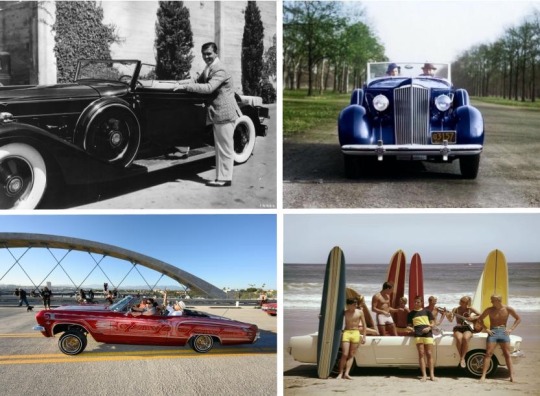
From Rhett Butler to beachgoers, everybody loved the convertible. Hulton Archive/H. Armstrong Roberts/Classicstock/Tom Kelley/Gary Leonard/Getty Images
Costing anywhere from $2K to $5K in the 1930s, roughly 2x-4x the average family income at the time, convertibles made by Duesenberg, Rolls-Royce, and Packard became status symbols for the prosperous few who could afford them.
“It is possible to follow the careers of stars through their motor cars,” noted a reporter in 1938. “When he or she first reaches the dizzy heights of movie fame, flash, gaudy cars are in order.”
Clark Gable owned a Packard convertible, and actor Wayne Morris preferred a topless ride in his Lincoln Zephyr “in any type of weather.” Marlene Dietrich was chauffeured in a tan Rolls-Royce convertible.
“No doubt,” wrote the reporter, “the gaudy car… satisfies a youthful ambition — and all of us have had it.”
The less starry got to fulfill their desires when Chevy, Lincoln, and Buick introduced roomy, space-aged convertibles in the ’50s and ’60s. My grandparents bought a 1962 seafoam-green Impala.
In 1964, Ford released the Mustang, the brainchild of famed auto developer and executive Lee Iacocca. Priced at ~$2.3K, or about one-third of the median family income, the Mustang was a magnet for middle-class Americans who wanted to inject adventure into their daily lives. It also helped bring annual convertible sales to ~500K in the mid-’60s, around 5% of total vehicle sales in America.
Safety concerns and a weak economy put a kibosh on convertible dreams in the ’70s. Cadillac claimed its ’76 Eldorado would be the last convertible ever designed, and total convertible sales fell to ~43K in 1982. But Iacocca reignited the flame with the release of the Chrysler LeBaron that year, ushering in the expanding convertible landscape I grew up with.

The Hustle
My dream car back then was a Dodge Viper, but I saw more practical convertibles everywhere in the ’90s, the peak era for manufacturers to turn the simplest of car models into adventure machines, equipped with rollover bars or fortified support pillars for safety.
The Pontiac Sunfire, Toyota Paseo, Chevrolet Cavalier, Mercury Capri, Honda Civic del Sol, Ford Probe, and Geo Metro (which could’ve lost to a riding lawn mower in a drag race) all had convertible versions.

The not-so-fast Geo Metro exemplified the wide variety of convertibles available a generation ago. Cars & Bids
Annual convertible sales Climbed to ~170K in the mid-’90s. They increased to ~315K in 2004, about 2% of the entire vehicle market, as automakers perfected the retractable hard top (and, somehow, convinced Americans to buy PT Cruiser convertibles).
Yet, as I failed to save for a Toyota Celica convertible by my 16th birthday — my realistic vision of a gaudy purchase — a tectonic market shift was underway. You could see it reflected in choices made from the Heartland to Hollywood.
After Good Will Hunting catapulted Matt Damon and Ben Affleck onto the A-list, for instance, they splurged on cars just like Gable, Morris, and other young stars before them.
Except they bought Jeep Grand Cherokees. “The really dope new truck at the time,” Affleck later explained to IMDB.
The SUV Loophole
Back in the late ’70s, the legal distinction that helped precipitate the decline of convertibles (and cars in general) seemed insignificant. A loophole the size of a needle eye.
In response to the oil crisis and a burgeoning environmental movement, federal regulations went into effect in 1978 requiring automakers’ passenger car fleets to meet a fuel standard of 18 miles per gallon. But “passenger cars” meant sedans, station wagons, coupes, and convertibles.
It didn’t apply to “light trucks” such as minivans, pickups, and SUVs, the latter two of which were mostly used by farmers, contractors, and laborers who needed the extra space for hauling material. To avoid placing an economic burden on workers, light-truck fleets were subjected to lower standards. While automakers had to shrink cars to hit the fuel standard, light trucks remained spacious.
So began an emphasis on SUVs and trucks (and minivans, at least until an association with soccer moms doomed them). SUV sales increased from ~112K in 1981 to ~800K in 1987.
Most Americans still didn’t need to haul anything, but they were hooked. In 1987, a J.D. Power and Associates survey even found SUV owners felt a sense of adventure while driving them — similar to a convertible.
For automakers, the economics checked out.
“You can sell a Cadillac for a lot more than a Chevy even though the Cadillac only costs marginally more to produce than a Chevy. The same thing goes for those truck-based SUVs because they’re sold as rugged,” says David Lucsko, an Auburn University professor who researches automotive history. “You can sell them at a premium and rake in the profits.”
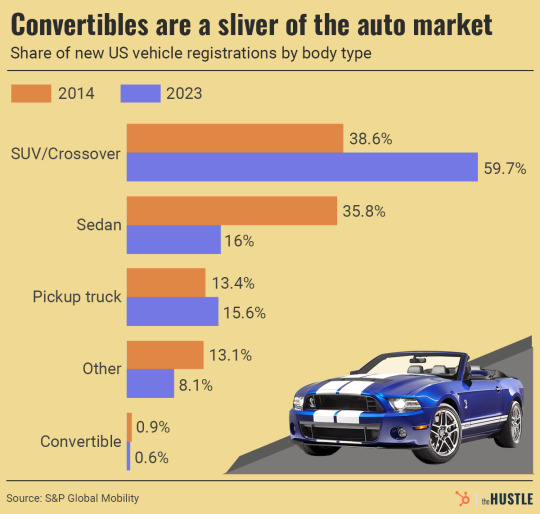
The Hustle
Later, brands popularized the crossover utility vehicle, giving consumers the space of an SUV with a smoother ride. Crossovers, despite being built on the same frame as a car, are typically classified as light trucks. The takeover was complete: Light trucks outsold cars for the first time in 2002. Their sales now comprise nearly 80% of the vehicle market.
No Cars Means No Convertibles
That shift has filled the roads with increasingly large vehicles, which is hardly an ideal environment for convertibles. But Drew Dorian, managing editor for Car and Driver, says he’s doubtful safety fears have driven their decline, noting that safety-concerned families would be unlikely to buy convertibles anyway.
The Insurance Institute for Highway Safety has found that, while SUVs have lower driver fatality rates than the average vehicle, convertibles aren’t any less safe than enclosed sedans or coupes.
Speaking of sedans and coupes: Many brands don’t even make them anymore. The only Ford car that hasn’t been discontinued in North America, for instance, is the Mustang. No more Taurus or Focus or Fusion. That’s been really bad for convertibles, which are typically derived from cars.
To develop all those ’90s convertibles, automakers just tweaked the design of popular sedans at a low cost. Now, according to Tom Libby, associate director of industry analysis and loyalty solutions at S&P Global Mobility, cars aren’t popular enough to justify turning into convertibles.
“To propose a convertible now, it’s almost impossible to create a proposal that includes a volume that’s big enough to make money,” he says.
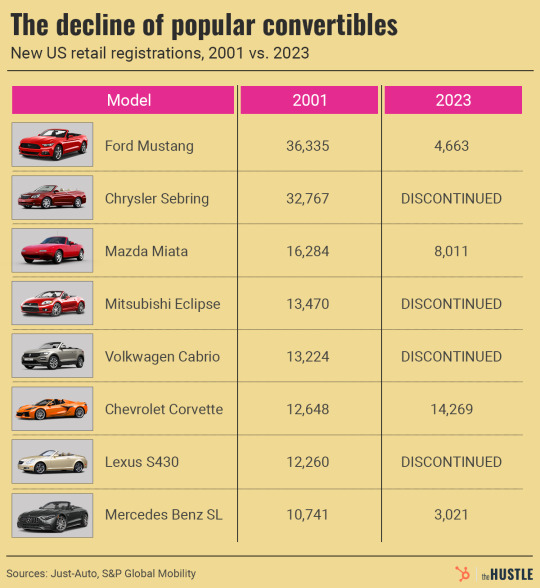
The Hustle
Money is also in short supply. Car companies are investing huge sums in the transition to electric vehicles, Libby says, and sales of EVs slowed last year, complicating the calculus of how to emphasize true EVs vs. hybrids.
Just as the purchase of a convertible requires a feeling of relative financial security and a sense of boldness, so does the act of designing one. And right now most automakers lack both.
Opting For Open Air
As with movies and clothing, trends rarely die in the auto industry. They go into hibernation until one successful experiment draws copycats and the trend becomes inescapable.
Just as the success of Iacocca’s Chrysler LeBaron led other brands to turn popular car models into convertibles in the ’80s and ’90s, Libby can imagine brands developing SUV convertibles as they seek niches for consumers demanding greater variation.
This makes sense: There’s increased time for adventure as millennials delay having kids or don’t have them at all. While summers may be excruciatingly hot, especially in the Sunbelt, the other seasons are warmer than ever. And Gen Zers crave experiences.
“The enjoyment of open air,” Libby says, “I don’t think that’s gone away.”
“But based on what happened to Nissan a few years ago,” he adds, “I don’t think [SUV convertibles are] imminent.”
He’s referring to Nissan’s crossover Murano convertible, which failed to gain traction in the 2010s. Land Rover’s Evoque was also swiftly discontinued. Americans spoke with their wallets: They didn’t want the open air.

The Land Rover Evoque. Andy Green/Land Rover via Getty Images
When I’m driving on temperate days, I rarely even see other drivers with their windows down. That might not be a coincidence. Lucsko, the car historian at Auburn, says automakers now design vehicles for consumers to seal themselves in.
“I think the car has become more and more a cocoon where we go to be isolated from the world,” he says.
Driving a convertible means being exposed to the world. It means embracing the elements and putting yourself out there, an ever-harder proposition in our increasingly curated, digital lives.
My own convertible era ended years ago. I had to ditch my Mustang for a move to hilly, snowbound central Pennsylvania. But I haven’t ditched my ambition for the open air, and I hope Americans haven’t either. Whether it’s a classic droptop or a futuristic roofless SUV, it will always feel good to say to hell with all that and buy a convertible.
#Transportation#Convertables#Open-air Dream#Climate-Controlled | Isolation#SUVs 🚙#Cars 🚙 🚗 🚘#The Hustle
0 notes
Link
The car will have three exterior design options Despite the fact that Toyota has already unveiled the new Camry , the sales start date has not been disclosed, and there is no information about when pre-orders will begin to be accepted. Meanwhile, the Chinese resource Autohome shared some details on this matter. [caption id="attachment_84270" align="aligncenter" width="780"] Toyota Camry[/caption] The all-new Toyota Camry will go on sale no earlier than March 2024. At least in China In China, sales of the ninth generation Camry are reported to start no earlier than March 2024. Orders will likely begin to be accepted in February during the so-called “Spring Festival” holidays surrounding the Chinese New Year (February 10, 2024). Another interesting point: it is reported that in China the Camry will receive three “faces”, although at the time of the announcement there were two options for external design. It is known that the purely petrol version with a 2-liter engine and the hybrid based on a 2.5-liter engine will have their own design options. And the third option may mean an additional styling package - usually these are offered for an additional fee.
#Automotive#automotive_design#car_model#car_specifications#fuel_efficiency#hybrid#hybrid_powertrain#hybrid_sedan#hybrid_technology#midsize_sedan#reliable_car#safety_features#sedan#toyota_camry#Toyota_Camry_features#Toyota_Motor_Corporation#vehicle_features
0 notes
Text
0 notes
Text
2024 Toyota Camry XSE
2024 Toyota Camry XSE – The Toyota Camry will share names with previous generations, but its extroverted styling and performance model makes it almost unrecognizable. This is because the current Camry is probably the most convincing to date. Although the standard is a humdrum, the four-cylinder engine is economical and a fine for a daily driver’s position.
2024 Toyota Camry XSE
The hybrid version provides maximum fuel economy, even if it is impossible to accelerate. This allows the 301-hp V-6 to pick up pace. Especially on a sporty Camry TRD, it’s actually fun to drive. While competitors like the Honda Accord and Hyundai Sonata are generally purer and more satisfying, Toyota has its own aspiring qualities. For example, a complete suite of standard active security features and a compliment resulting from decades of proven reliability.
https://toyotacarsmodels.com/2024-toyota-camry-xse/
0 notes
Text
2024 Toyota Camry Interior, Colors, Release Date
2024 Toyota Camry Interior, Colors, Release Date
2024 Toyota Camry Interior, Colors, Release Date – Toyota Camry was launched because of the compact car in the year 1982. However, as time passed on, it had been remodeled so that as we articulate, we also have a middle of the the-sizing vehicle. Rumors get it that this 2024 Toyota Camrywill have the most magnificent redesign from the model’s record. In the beginning, there are testimonies how…
View On WordPress
#2024 Toyota Camry#2024 Toyota Camry Android Auto#2024 Toyota Camry Apple Carplay#2024 Toyota Camry Awd#2024 Toyota Camry Carplay#2024 Toyota Camry Changes#2024 Toyota Camry Colors#2024 Toyota Camry Configurations#2024 Toyota Camry For Sale#2024 Toyota Camry Hybrid#2024 Toyota Camry Interior#2024 Toyota Camry Le#2024 Toyota Camry Pics#2024 Toyota Camry Price#2024 Toyota Camry Release Date#2024 Toyota Camry Se#2024 Toyota Camry Sport#2024 Toyota Camry Xle#2024 Toyota Camry Xse#2024 Toyota Camry Xse V6#toyota Camry 2024 Model
0 notes
Text
New 2023 Toyota Camry Hybrid Powertrain, For Sale, Redesign
New 2023 Toyota Camry Hybrid Powertrain, For Sale, Redesign
New 2023 Toyota Camry Hybrid Powertrain, For Sale, Redesign – Camry refresher is for 2023. The new Camry will probably be offered in 2023 or 2024. Avalon also will get a refresher in 2023.
There is likewise a new Corolla crossover in 2023 and a Sienna Hybrid minivan. So 2023 is shaping as much as be an active year for Toyota’s new product release.
Toyota will expose new technological innovation…

View On WordPress
#2023 toyota camry hybrid awd#2023 toyota camry hybrid colors#2023 toyota camry hybrid release date#2023 toyota camry hybrid specs#2023 toyota camry hybrid xse#2023 toyota camry plug in hybrid#does camry have a plug in hybrid#is there a toyota camry plug in hybrid#is toyota camry hybrid awd#p3191 toyota camry hybrid#toyota camry hybrid 0 to 60#toyota camry hybrid 07#toyota Camry Hybrid 2023#toyota camry hybrid 6 cylinder#toyota camry hybrid dealers#toyota camry hybrid new for sale#toyota camry hybrid powertrain#toyota camry hybrid rating#toyota camry hybrid specials#toyota camry hybrid v6
0 notes
Text
%news%
New Post has been published on %http://paulbenedictsgeneralstore.com%
These are the 11 best midsize family sedans you can buy for less than $30,000
Hyundai Sonata.
Hyundai
SUV and crossover gross sales are sturdy, nonetheless let's no longer ignore midsize sedans.
Midsize sedans are also functional for families and cargo, even though some fashions are being squeezed out of the market completely as patrons flock to bigger alternate choices.
Right here are 11 midsize sedans you would possibly well perchance purchase for decrease than $30,000.
Scuttle to Industrial Insider's homepage for extra reviews.
Whenever you happen to survey around on the sea of egg-formed SUVs and crossovers on the road and damage up overcome with a mode of existential fear over the fate of little automobiles, fear no longer! Opposite to gross sales data, SUVs usually are not the particular automobiles available to you while you are going to have gotten a family and in addition want trunk space for every part else.
There are quiet numerous correct and pleasing midsize sedans quiet available, even while you feel as even supposing the sedan apocalypse is upon us. The compatible data is you would possibly well perchance furthermore derive some surely correct ones for $30,000 or less.
The United States Environmental Protection Agency defines the midsize class as a sedan that has an interior passenger and cargo quantity between 110 cubic feet and 119 cubic feet. For the sake of simplicity, let's correct take into consideration one thing in regards to the measurement of a Toyota Camry.
Right here are 11 of the particular ones.
Honda Accord
Honda Accord.
Honda
When of us deem of midsize sedans, they on the total deem of the Honda Accord — and for correct reason.
Honda's been making the Accord as a result of the mid '70s and it is consistently one in every of primarily the most celebrated automobiles in america. Ever since Honda opened its first US plant in Marysville, Ohio, in 1979 and commenced producing American-made Accords in 1982, bigger than 10.5 million Accords had been inbuilt the US. It changed into once the well-known some distance off places car to be manufactured on US soil, in step with Edmunds.
This day's Accord would possibly well perchance furthermore be had in a pair of numerous suggestions. First, there's your regular Accord sedan, which you are going to derive in numerous trims (and in addition with a six-jog manual transmission, while you choose for the Sport tidy).
There's also a hybrid, for those purchasing for one thing extra surroundings friendly. The EPA claims the Accord Hybrid's mpg score is spectacular — 48 mpg within the metropolis, 47 mpg on the dual carriageway, and 48 mpg mixed.
And as some distance as automobiles for the a lot attain, its styling is shapely and inoffensive, appealing to the mass market.
Prices inaugurate at $24,020.
Toyota Camry
Toyota Camry.
Toyota
Whenever you happen to would possibly well perchance well have got ridden in an Uber or a Lyft within the past two or three years, probabilities are you are going to have got skilled the Toyota Camry firsthand. The Camry is Toyota's technique to the Accord, and or no longer it is some distance also somewhat gigantic at its well-known job of being a car.
The Camry's reputation as a stir-hailing car is not any coincidence. It has a giant wait on seat and a big trunk. The seats are happy and the out of doors doesn't survey defective, either. You would possibly be ready to have it with correct the gasoline motor, otherwise you would possibly well perchance derive it with the hybrid powertrain. Mileage estimates for the hybrid are 51 mpg within the metropolis, 53 mpg on the dual carriageway, and 52 mpg mixed, in step with the EPA.
And if that wasn't correct sufficient, the Camry also has a secret weapon: Whenever you happen to derive it with the V6 in among the most upper trims, you are going to derive a Camry that has 301 horsepower. A Camry! That's nearly as grand horsepower as a unsafe Ford Mustang. That would had been unparalleled correct a pair of years ago.
The energy bump puts you past the $30,000 impress level, nonetheless I correct wished you all to be unsleeping.
Usual Camrys and the hybrid enact no longer derive 300 horsepower, nonetheless they enact impress under $30,000, and numerous fashions now have non-fundamental all-wheel power in desire to correct front-wheel power.
Prices inaugurate at $24,425.
Mazda 6
Mazda 6.
Mazda
Latest Mazdas have risen up the ranks favorably for consistently punching above their weight class. Catch into any new Mazda this day — steal up the trims, materials, and fabrics mild — and you would possibly well perchance presumably also be convinced the inside is from one thing grand extra costly and upmarket.
All of that would furthermore be had within the fashionable equipment of the Mazda 6. Two engine alternate choices are available. The first is a 2.5-liter four-cylinder that is correct for 187 horsepower. The second is a somewhat extra costly turbocharged 2.5-liter that is correct for 250 horsepower.
Notably, the 250-horsepower unit has a excessive torque figure, with 310 pound-feet when put next with 186 pound-feet on the less extraordinary engine. But, as a result of the Mazda 6 is front-wheel power, all that energy being despatched to the front wheels can reason one thing known as torque steer — the tendency for a torque-chuffed FWD car to drag to the side when it accelerates. Tranquil, the energy is numerous stress-free.
Whenever you happen to enact lastly terminate up with the Mazda 6, enact steal into consideration getting it in Mazda's shapely Soul Purple Crystal Metal coloration of paint. It looks to be like correct on sunny days, cloudy days, and every part in between.
Prices inaugurate at $24,100.
Nissan Altima
Nissan Altima.
Nissan
Nissan is nonetheless one in every of the numerous automakers, including Hyundai and Mazda, centered on bringing developed driver-support skills to the a lot.
Nissan ProPilot is the automaker's semi-independent driver support and security skills. Ceaselessly, you would come by linked tech in extra expensive automobiles, nonetheless Nissan announced it would possibly well perchance presumably also be available on the new Altima two years ago. That suggests developed security ingredients usually are not completely a toy for the smartly off anymore.
The Altima is available in either front-wheel power or all-wheel power.
Prices inaugurate at $24,100.
Subaru Legacy
Subaru Legacy.
Subaru
Subaru will most probably be vital for its Forester, Crosstrek, and Outback fashions, nonetheless the Japanese automaker also does provide a midsize sedan within the execute of the Legacy.
The Legacy, now in its seventh era, has elevated security, as smartly as improved noise, vibration, and harshness qualities. Power comes from a 2.5-liter, boxer four-cylinder motor that is correct for 182 horsepower.
The consistently variable computerized transmission admittedly feels cherish a limited bit of a lumber to use. In any other case, the Legacy has inoffensive exterior styling and all-wheel power for those frosty days.
Prices inaugurate at $22,745.
Chevrolet Malibu
Chevrolet Malibu.
Chevrolet
Whenever you happen to are seeking to retain the price of your Chevy Malibu under $30,000, you would possibly well derive it with the 1.5-liter, turbocharged four-cylinder engine.
Unfortunately, the Malibu, which began production within the '60s, would possibly well perchance merely no longer stick around for some distance longer. Gross sales are down and there's pronounce that the auto will probably be discontinued altogether by 2024. In 2019, The Automobile Connection confirmed that the Malibu hybrid would possibly well perchance presumably be axed from the 2020 lineup.
However while you deem or no longer it is some distance your life's calling to absorb a brand new Malibu, they're quiet around for a limited bit longer.
Prices inaugurate at $22,095.
Kia Optima
Kia Optima.
Kia
The days of Korean automobiles having flimsy invent quality are over. The fashionable Kias are classy, sporty, and a lot extra upmarket than Kias of a mere 5 years ago. Kia's midsize sedan offering, the Optima, also has a hybrid option.
The regular Optima has a 2.4-liter, four-cylinder engine that produces 185 horsepower. There's also a 1.6-liter, four-cylinder turbocharged engine option that produces 178 horsepower. The hybrid Optima is correct about $30,000, and presents an EPA-estimated 42 mixed dual carriageway and metropolis mpg.
Prices inaugurate at $23,390.
Hyundai Sonata
Hyundai Sonata.
Hyundai
The brand new Hyundai Sonata is one in every of the sleekest automobiles to inaugurate in contemporary memory. Its front fascia and overall form bring European silhouettes to mind.
The harmful-tidy Sonata makes 191 horsepower from a 2.5-liter four-cylinder engine, whereas the tip-tidy option produces 180 horsepower from a turbocharged 1.6-liter, four-cylinder engine. Inner, the new Sonata is futuristic and minimalist.
There's also a hybrid version, with the updated physique fashion on the potential. The 2019 hybrid model is quiet the particular one listed on Hyundai's net pages, even supposing, meaning or no longer it is quiet obtained the outgoing Sonata's physique fashion.
The outgoing hybrid 2019 Sonata will get an EPA-estimated 39 mpg within the metropolis, 44 mpg on the dual carriageway, and 41 mpg mixed. Whereas the 2020 is not always surely on Hyundai's net pages yet, it is on the EPA's, with estimates of 45 mpg within the metropolis, 51 mpg on the dual carriageway, and 47 mpg mixed.
Prices for the gasoline-powered 2020 model inaugurate at $23,600.
Volkswagen Passat
Volkswagen Passat.
Volkswagen
The Volkswagen Passat is the particular European offering on this list.
Bigger than the Jetta nonetheless smaller than the Arteon, the Passat occupies that candy space between the 2. It's miles a pointy-having a survey thing — and with the match and terminate of European luxury.
What's extra is that you would possibly well perchance presumably be derive the sportier R-Line tidy and quiet handle issues under $30,000. The R-Line has somewhat extra aggressive styling and sporty, 19-disappear alloy wheels.
All Passat fashions are powered by a 2.0-liter, turbocharged four-cylinder engine that produces 174 horsepower. That energy is shipped to the front wheels by a six-jog computerized transmission.
Prices inaugurate at $22,995.
Buick Regal Sportback
Buick Regal Sportback.
Buick
At the tip of 2019, Buick announced it would end building its total Regal lineup on the tip of the 2020 model twelve months. That involves the Regal Sportback, GS, and TourX space wagon. However whereas or no longer it is quiet around, let's revisit the Regal Sportback.
The Regal is as good a car as any. The inside is ergonomically position up and the Sportback version has a trim hatchback opening derive, which must derive packing the trunk less complicated. The automobile is powered by a 2.0-liter turbocharged four-cylinder that will get an estimated 22 mpg within the metropolis and 32 mpg on the dual carriageway.
It's roughly a disgrace the Regals are going away, as a result of they are a pleasing change to the crossover- and SUV-heavy Buick lineup. Correct a signal of the occasions, I command.
Prices inaugurate at $25,370.
Ford Fusion
Ford Fusion.
Ford
Ford has also made announcements in terms of the Fusion sedan's cancelation, nonetheless that would possibly well perchance merely no longer happen until 2021. You would possibly want obtained a limited bit time left to bring one home while you want.
There's also a hybrid option. It will get an EPA estimate of 43 mpg within the metropolis and 41 mpg on the dual carriageway. The regular, gasoline engine-greatest Fusion nets an estimated 23 mpg within the metropolis and 34 mpg on the dual carriageway.
The Fusion is the closing sedan Ford for the time being presents. After or no longer it is gone, the total Ford lineup will encompass SUVs, crossovers, and the Mustang.
Prices inaugurate at $23,170.
More: BITranspo Sedan Midsize Sedans Automobiles
0 notes
Text
2024 Toyota Camry Interior, Release Date And Price
2024 Toyota Camry Interior, Release Date And Price
2024 Toyota Camry Interior, Release Date And Price– Later on, there will be yet another manufacturing to become presented as Toyota Camry, 2024 the producer provides the big system of lightweight aluminum units to make use of the auto to re-design this marketplace. Moreover, the state producer offers the new composition potent body equipped areas of the information together with the best design…
View On WordPress
#2024 Toyota Camry#2024 Toyota Camry Android Auto#2024 Toyota Camry Apple Carplay#2024 Toyota Camry Awd#2024 Toyota Camry Carplay#2024 Toyota Camry Changes#2024 Toyota Camry Colors#2024 Toyota Camry Configurations#2024 Toyota Camry For Sale#2024 Toyota Camry Hybrid#2024 Toyota Camry Interior#2024 Toyota Camry Le#2024 Toyota Camry Pics#2024 Toyota Camry Pictures#2024 Toyota Camry Price#2024 Toyota Camry Release Date#2024 Toyota Camry Se#2024 Toyota Camry Sport#2024 Toyota Camry Xle#2024 Toyota Camry Xse#2024 Toyota Camry Xse V6
0 notes